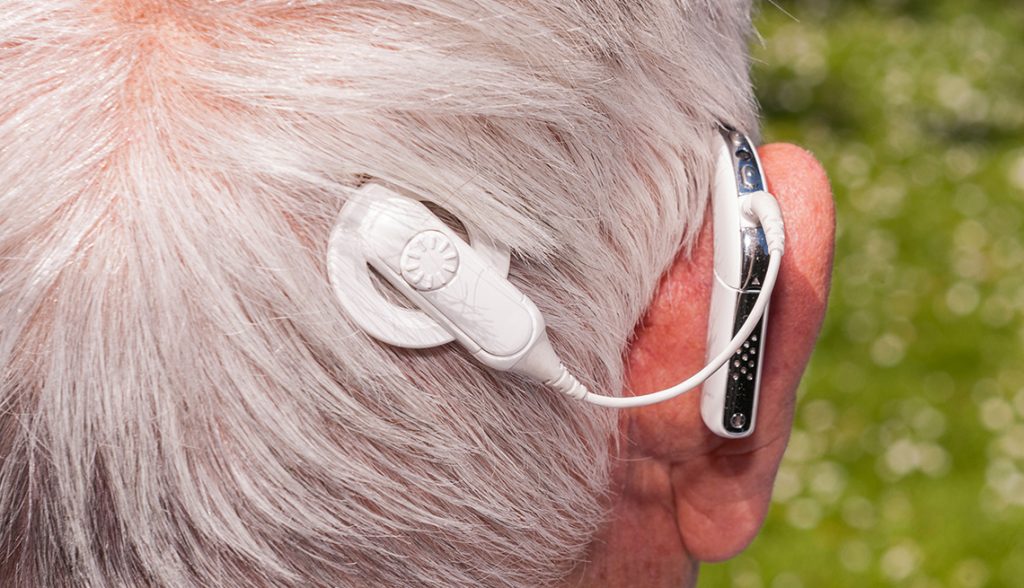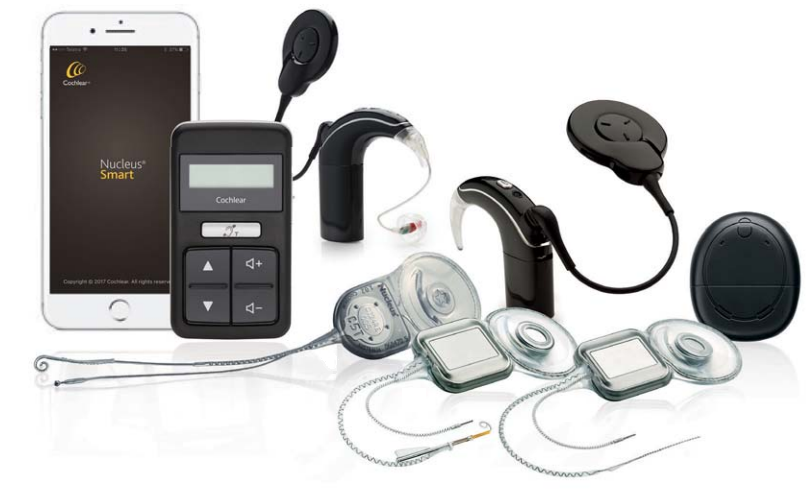Cochlear implants
With the right device programmed correctly and used regularly, most people with hearing loss get significant benefit from hearing aids.
However, when hearing loss is significant and the hearing cells and nerves are damaged in a way that affects sound clarity, not volume, hearing aids may provide limited benefit. In these situations, simply making unclear sounds louder is not particularly helpful.
When hearing aids aren’t providing benefit for someone with significant hearing loss, cochlear implants are worth considering.
Cochlear implants, a true wonder of modern medical science, substitute for damaged hearing nerves by both processing sound and sending sound signals to the brain.

How it Works
Cochlear implants consist of the following key components:
- external – sound processor (1 in the diagram below) and coil (2)
- internal – implant (3), electrode and electrode array (4)
The system workings include:
- microphones in the sound processor (1) convert sound into digital information
- digital information is transferred to the coil (2) and then to the implant (3) which sits just under the skin
- the implant (3) converts digital information into electrical signals which are then transferred to the cochlea (inner ear)
- within the cochlea, the electrode stimulates nerve fibres which transfers signals along the auditory nerve (5) to the brain to be interpreted as sound
In some cases, an additional acoustic component also delivers amplified sound to the ear canal (6). The sound is then transmitted along the normal auditory pathway – from the outer ear to the middle ear and inner ear.
In other cases, the sound processor (1) and the coil (2) can be combined into a single component that sits above and behind the ear.

Types of Cochlear implants
Cochlear implant systems come in a wide variety of configurations and component types. Accessories such as phone apps, control units, wireless microphones, phone clips and TV streamers are also available.
Cochlear implant systems are individually tailored to each client. Factors determining component suitability include the specific nature of a client’s hearing loss and their physical attributes, as well as lifestyle needs and personality.

Cochlea implant product range – Cochlear (image source – Cochlear website)
Implantation process
While every individual case is different, the fundamental steps of the implantation process for Cochlear implants are generally as follows:
1 Hearing test and candidacy assessment
A full diagnostic hearing test is undertaken by Mackay Hearing’s experienced Audiologist to determine the type and extent of hearing loss and your potential candidacy for a Cochlear implant will be discussed.
A full candidacy assessment will then be carried out by our Audiologist in a separate appointment. If the assessment confirms your candidacy, a referral to an Ear, Nose and Throat (ENT) Specialist will be issued.
2 Medical investigations and assessment
The ENT Specialist will carry out various medical investigations and assessments to determine whether you are medically suitable for a Cochlear implant.
3 Counselling
Receiving a Cochlear Implant is a major procedure requiring extensive adjustment and ongoing support. Therefore, upon confirmation of medical suitability from the ENT Specialist, the next step is to have a comprehensive counselling appointment with our Audiologist.
4 Surgery
Implantation is carried out by the ENT Specialist in a hospital surgery. It is likely that the ENT Specialist will request post-surgery follow-up appointments.
5 Switch-on and mapping
Upon clearance from the ENT Specialist, the device is ‘switched-on’ during an appointment with our Audiologist.
After switch-on, regular appointments with our Audiologist are held so ‘mapping’ can be undertaken. Mapping is acoustic adjustments and refinements to ensure optimal hearing. Appointments can also involve counselling to assist the client adjust to the system.
Mapping appointments may be necessary for a period of up to 12 months after switch-on, however the length and number of appointments required in the mapping period will depend on your progress adjusting to the system.
6 Ongoing support
Cochlear implant success requires much more than just implanting a device, switching it on and leaving you to your own devices.
Cochlear implantation is a major procedure requiring extensive adjustment and ongoing support. After switch-on and comprehensive mapping, our Audiologist will conduct reviews annually (or more frequently if necessary).
We encourage clients to attend our peer support group – Hear With You Mackay. We can also connect clients with local Cochlear implant recipients that volunteer their time to support and assist fellow recipients.
Cochlear implant costs
Mackay Hearing offer medical rebates for all Audiological appointments directly related to Cochlear implants (candidacy assessment, pre-surgery counselling, switch-on, mapping and ongoing reviews).
In addition, many Australian private and government health insurance plans cover the cost of Cochlear implants and Medicare can cover part of the surgery costs.
If you would like further information or wish to make an appointment, please contact our friendly local staff directly on (07) 4952 4649, email us at listening@mackayhearing.com.au, or leave us a message on our website.
